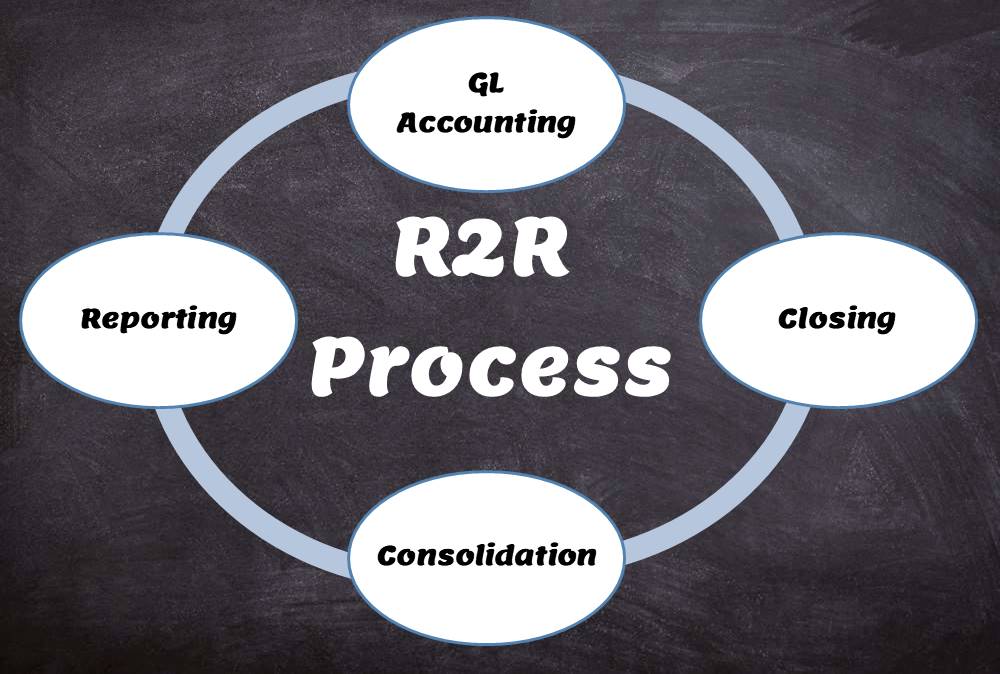- Home
- Business Processes
- Industry Knowledge
- Aerospace Industry
- Automotive Industry
- Banking Domain
- BFSI Industry
- Consumer/ FMCG Industry
- Chemicals Industry
- Engineering & Construction
- Energy Industry
- Education Domain
- Finance Domain
- Hospitality Domain
- Healthcare Industry
- Insurance Domain
- Retail Industry
- Travel and Tourism Domain
- Telecom Industry
- Leadership Skills
- eLearning
- Home
- Functional
- General Ledger (Record to Report)
- Record to Report Process
Record to Report Process
Record to report (R2R) is a finance and accounting management process that involves collecting, processing, analyzing, validating, organizing, and finally reporting accurate financial data. R2R process provides strategic, financial, and operational feedback on the performance of the organization to inform management and external stakeholders. R2R process also covers the steps involved in preparing and reporting on the overall accounts.
Definition of Record to Report Process
This function helps to assist the companies in the preparation and submission of various statutory reports that require in-depth and specialized domain knowledge. This process enables companies to consolidate global performance across various channels and create global income statements and balance sheets. This provides visibility to various channel heads to understand and comment on the key variance drivers with reference to plans and past years' performance. All the activities from recording to reporting of transactions are included in the "Record to Report" process also known as "R2R", “Account to Report”, “A2R”, General Ledger, “Finance & Accounting” process. People with extensive training/experience with knowledge of client/country-specific requirements are important for building an effective “Record to Report” process.
The R2R Process
The record-to-Report process is an end-to-end process that includes, general accounting, sub-ledger accounting, tax compliance, regulatory compliance, financial analysis, and reporting and interacts with the functions of budgeting and forecasting and internal and external audit. It includes all subsequent activities after the recording financial transactions related to the financial close consolidation, through the external reporting of the Company’s financial results. The R2R process ends with the completion of account reconciliations of balances generated during the financial close process.
The four core steps in the record to report process are
- General Ledger Accounting
- Closing of Books
- Consolidation of Accounts
- Reporting of Financials
1. General Ledger Accounting:
The processing cycle is where the majority of data required for the Record to Report process is generated. The R2R process begins when recording occurs in a general ledger singly or jointly on Management GAAP and Statutory accounting basis. This step happens once the maintenance and closure of sub-ledgers are completed. Recording transactions includes documenting revenues (by invoices or sales receipts), and entering purchases (in the account payable account) and expenditures (in the check register). This step sometimes also involves high-level accounting tasks, such as recording sales orders, tracking prospective customers, and projecting sales opportunities and cash flow.
To record and classify a transaction to appropriate accounts, a proper understanding of the accounting equation is and accounting standards and practices is a must. Calculating and summarizing transactions in a traditional accounting system is a tedious process and automated accounting frees accountants from these repetitive tasks by calculating and summarizing hundreds or thousands of individual transactions and generating reports to satisfy a variety of stakeholders.
2. The Closing Cycle:
Once the processing cycle is complete, the next cycle is to close the books. Closing of Management GAAP books is done following the common R2R Organizational Global Closing Calendar along with the closing of statutory accounting books. Close Cycle is the elapsed time for posting transactions to the general ledger and financial reporting systems through locking down the general ledger.
3. The Consolidation Cycle:
The consolidation cycle is the next pivotal step in the Record to Report process and this step allows companies to perform eliminations, reconcile intercompany balances and produce the data required to generate financial statements by entities. The consolidation cycle must address both internal and external reporting needs. Consolidation and elimination include completion of within and outside own Business eliminations, intercompany reconciliations, and other post-close activities leading to final financial statements at the consolidated “Consolidating Entity” segment level.
4. Reporting Cycle:
The reporting cycle is the formal process of data gathering, assimilating, performing analysis, and distributing the results. Throughout a leading practice close and consolidation cycle, management is receiving reports that address key indicators and statistics. The key to this process is the flow of the information necessary to provide accuracy in an efficient manner. This would include information from all source systems and sometimes requires a support process to accomplish it. Reporting cycle includes submission of financial data and commentary to the Organization’s Corporate Headquarters, external reporting, and government reporting.
The accounting system records the economic data about business activities and events, the next logical step is to prepare the business reports and provide them to the stakeholders according to their informational needs. The double-entry system enables accountants to prepare some standard reports like trial balance, profit and loss account, and balance sheet. Accounting reports are based on generally accepted accounting standards and these reports are powerful tools to help the business owner, accountant, banker, or investor analyze the results of their operations. Stakeholders use accounting reports as a primary source of information on which they base their decisions. They use other information as well. For example, in deciding whether to extend credit to a company, a banker might use economic forecasts to assess the future demand for the company’s products. The banker might inquire about the ability and reputation of the managers of the business.
Importance of Record to Report:
The accuracy and integrity of the financial statements largely depend on the efficiency of transactional bookkeeping activities. People with extensive training/experience with knowledge of client/country-specific requirements are important for building an effective “Record to Report” process. This function helps to assist the companies in the preparation and submission of various statutory reports that require in-depth and specialized domain knowledge. This process enables companies to consolidate global performance across various channels and create global income statements and balance sheets. This provides visibility to various channel heads to understand and comment on the key variance drivers with reference to plans and past years' performance.
Related Links
You May Also Like
-
GL - Unearned / Deferred Revenue
Unearned revenue is a liability to the entity until the revenue is earned. Learn the concept of unearned revenue, also known as deferred revenue. Gain an understanding of business scenarios in which organizations need to park their receipts as unearned. Look at some real-life examples and understand the accounting treatment for unearned revenue. Finally, look at how the concept is treated in the ERPs or automated systems.
-
Matrix Organizational Structures
In recent times the two types of organization structures which have evolved are the matrix organization and the network organization. Rigid departmentalization is being complemented by the use of teams that cross over traditional departmental lines.
-
Operational Structures in Business
Large organizations grow through subsidiaries, joint ventures, multiple divisions and departments along with mergers and acquisitions. Leaders of these organizations typically want to analyze the business based on operational structures such as industries, functions, consumers, or product lines.
-
Generally Accepted Accounting Principles define the accounting procedures, and understanding them is essential to producing accurate and meaningful records. In this article we emphasize on accounting principles and concepts so that the learner can understand the “why” of accounting which will help you gain an understanding of the full significance of accounting.
-
As the business grows, the company may want to transition to a branch structure as branches are allowed to conduct a much broader range of activity than representative offices. Branches can buy and sell goods, sign contracts, build things, render services, and generally everything that a regular business can do. A company expands its business by opening up its branch offices in various parts of the country as well as in other countries.
-
What is a Business Eco System?
The goal of a business is to generate capital appreciation and profits for its owners or stakeholders by engaging in provision of goods and services to customers within the eco system/framework governed by respective laws(local/international). The eco system involves various entities that the business works with for delivery of a product or service.
-
A legal entity is an artificial person having separate legal standing in the eyes of law. A Legal entity represents a legal company for which you prepare fiscal or tax reports. A legal entity is any company or organization that has legal rights and responsibilities, including tax filings.
-
General Ledger - Advanced Features
Modern automated general ledger systems provide detailed and powerful support for financial reporting and budgeting and can report against multiple legal entities from the single system. These systems offer many advanced functionalities right from journal capture to advanced reporting. This article will provide an overview of some advanced features available in today's General Ledgers.
-
Concept of Representative Office
A representative office is the easiest option for a company planning to start its operations in a foreign country. The company need not incorporate a separate legal entity nor trigger corporate income tax, as long as the activities are limited in nature.
-
GL - Different Accounting Methods
The accounting method refers to the rules a company follows in reporting revenues and expenses. Understand the two common systems of bookkeeping, single, and double-entry accounting systems. Learners will also understand the two most common accounting methods; cash and accrual methods of accounting and the advantages and disadvantages of using them.
Explore Our Free Training Articles or
Sign Up to Start With Our eLearning Courses

About Us
Learning
© 2023 TechnoFunc, All Rights Reserved










